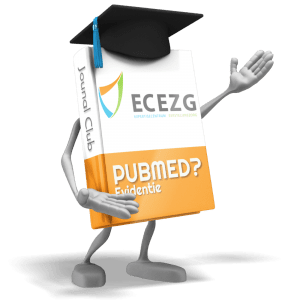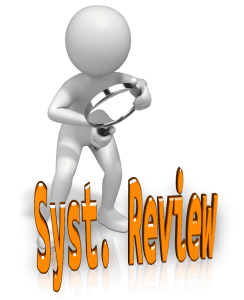Elke laatste dinsdag van de maand organiseert ECEZG een Journal Club Fysiotherapie in Groningen. Dinsdag 27 oktober 2015 was de eerste bijeenkomst. Maandelijks staan er vaste onderdelen op het programma, waarvan op deze blog achteraf een samenvatting komt te staan.
Een Journal Club is een wijze van implementatie van EBP;
- Het formuleren van kritische en beantwoordbare vragen voortkomend uit een klinische onzekerheid.
- Het op efficiënte wijze zoeken van relevante wetenschappelijke literatuur.
- Het kritisch beoordelen van de validiteit en de resultaten van deze literatuur.
- Het beoordelen van de toepasbaarheid van de resultaten in de klinische praktijk.
- De evaluatie van de gevolgen van een gekozen handelwijze.

De Journal Club Fysiotherapie in Groningen telt 12 deelnemers. Alle deelnemers hebben verschillende achtergronden; qua opleiding en interesse gebied (Fysiotherapiewetenschap, Klinische Epidemiologie, Psychosomatische Therapie, Manuele Therapie, Orofasciale Therapie, Cardiorespiratoire Revalidatie en Pijn Revalidatie), niveau (Professional Master, MSc en PhD) en setting waarin ze werkzaam zijn (verschillende eerstelijnspraktijken, universitair ziekenhuis, Hanzehogeschool).
Statistiek
Een korte opfrisser over het betrouwbaarheidsinterval; van interpretatie tot aan de wijze van berekenen bij een gegeven dataset.
In plaats van deze theorie hier volledig uit te typen, zie de volgende filmpjes:
Critical Appraisal
Bespreken van een van te voren uitgereikt artikel op methodologische en statistische kwaliteit. Ditmaal een ongepubliceerd artikel, een RCT, waarin de McKenzie methode met stabiliteitsoefeningen werd vergeleken bij mensen met chronische lage rug klachten, is kritisch bekeken door de deelnemers. Gezien dit om een ongepubliceerd artikel ging, wordt er geen verdere informatie over de critical appraisal gegeven.
Nieuwe Critical Appraisal voor volgende bijeenkomst
In de volgende bijeenkomst zal er een Systematic Review worden besproken welke het onderwerp ‘leergesprek’ omvat. Welke SR het precies gaat worden zal in de volgende blog blijken.
Nieuwe Centrale Vraag
Tijdens elke Journal Club wordt er gezamenlijk een praktijkgerichte vraag geformuleerd waar alle deelnemers een antwoord op proberen te vinden door een zoektocht naar artikelen te starten.
De vraag voor de volgende keer luidt: ‘Hoe groot is de invloed van een leergesprek bij patiënten (ongeacht welke aandoening) op een positief behandelresultaat?’
Hoewel dit een zeer brede vraag op het moment is, willen we deze interventie in het algemeen beschouwen, voordat we deze gaan specificeren op diverse aandoeningen. Daarnaast nemen we pijneducatie als specifieke interventie niet mee, gezien hier al meer over bekend is bij de deelnemers.
De mogelijke antwoorden op deze vraag zijn terug te vinden in de volgende Journal Club blog.
Update Journals
Maandelijks wordt er een update gegeven van potentieel interessante titels uit de meest recente uitgave van diverse Journals. De organisatie screent de Journals en maakt hieruit een selectie van titels van artikelen. Bij interesse kan het volledige artikel opgezocht worden via de gangbare wegen.
 JOSPT
JOSPT
- Kinematic and Kinetic Analysis of the Single-Leg Triple Hop Test in Women With and Without Patellofemoral Pain – Curcio Dos Reis
Bijdrage: Dames met PFP hebben veranderde kinematics in romp/heup/knie/enkel - Excursion of the Sciatic Nerve During Nerve Mobilization Exercises: An In Vivo Cross-sectional Study Using Dynamic Ultrasound Imaging – M. Coppieters en R.J.Nee
Bijdrage: Theorie van gliders/sliders lijkt te kloppen, net als bij ULTT’s
Journal of Physiotherapy (UK)
- Does outpatient physical therapy with the aim of improvinghealth-related physical fitness influence the level of physicalactivity in patients with long-term musculoskeletalconditions? – I.Holm
Bijdrage: Significante verbetering bij outpatient fysio, gemeten middels MET-min/week - Identifying potential moderators for response to treatmentin low back pain: A systematic review – Tara Gurung
Bijdrage: Moderators zijn leeftijd, hebben van baan, ernst van rugklacht, gebruik van narcotica, verwachting en opleidingsniveau. Niet sterk genoeg om te gebruiken in de praktijk.
Manual Therapy
- Validation of the pectoralis minor length test: A novel approach – Weber
- Pain education combined with neck- and aerobic training is more effective at relieving chronic neck pain than pain education alone. A preliminary randomized controlled trial – Brage
- Neck muscle endurance and head posture: A comparison between adolescents with and without neck pain – Oliveira / Silva
- Is exercise effective for the management of subacromial impingement syndrome and other soft tissue injuries of the shoulder? A systematic review by the Ontario Protocol for Traffic Injury Management (OPTIMa) Collaboration
- Investigating the contribution of the upper and lower lumbar spine, relative to hip motion, in everyday tasks – Alqhtani / Williams
- Effects of a movement training oriented rehabilitation program on symptoms, functional limitations and acromiohumeral distance in individuals with subacromial pain syndrome – Savoie / Roy
- Does training frequency and supervision affect compliance, performance and muscular health? A cluster randomized controlled trial – Dalager / Sjogaard
- A tailored exercise program versus general exercise for a subgroup of patients with low back pain and movement control impairment: A randomised controlled trial with one-year follow-up – Saner / Luomajoki / de Bie
- A qualitative exploration of people’s experiences of pain neurophysiological education for chronic pain: The importance of relevance for the individual – Robinson / Martin
Physical Therapy
- Promoting health and wellness: Implications for physical therapist practise.
To provide a basis for understanding the terms “health” and “wellness”, to identify the knowledge and skills physical therapists need to address behaviours that promote health and wellness and treat and protect against chronic disease, and to discuss barriers and opportunities associated with integrating the promotion of health and wellness into physical therapist practice. - Assessing balance function in patients with total knee arthroplasty.
Conclusion: The 3 BESTests have good reliability and validity for evaluating balance in people with TKA. The Brief-BESTest is the least time-consuming and may be more useful clinically. - Clinical decision-making tool for safe and effective prescription of exercise in acute exacerbations of chronic obstructive pulmonary disease: Results from an interdisciplinary Delhpi survey and focus groups.
Conclusion: The exacerbations of chronic obstructive pulmonary disease (AECOPD-Mob) provide practical and concise information on safe and effective exercise for the AECOPD population for use by the new graduate or novice acute care practitioner.
Journal of Pain
- Are children the better placebo analgesia responders? An experimental approach.
Conclusion: This study is the first to experimentally explore placebo analgesia and influence of previous experience on placebo responses in children compared with adults. We found comparable placebo responses in both groups and an increased relevance of learning processes for treatment outcome in children.
Journal of Physiotherapy (Aus)
- The manual Diaphragm release technique improves diaphragmatic mobility, inspiratory capacity and exercise capacity in people with chronic obstructive pulmonary disease: a randomised trial.
Conclusion: The manual Diaphragm release technique improves diaphragmatic mobility, exercise capacity and inspiratory capacity in people with chronic obstructive pulmonary disease. This technique could be considered in the management of people with chronic obstructive pulmonary disease.
Volgende Journal Club Fysiotherapie
Dinsdag 24 November



 JOSPT
JOSPT